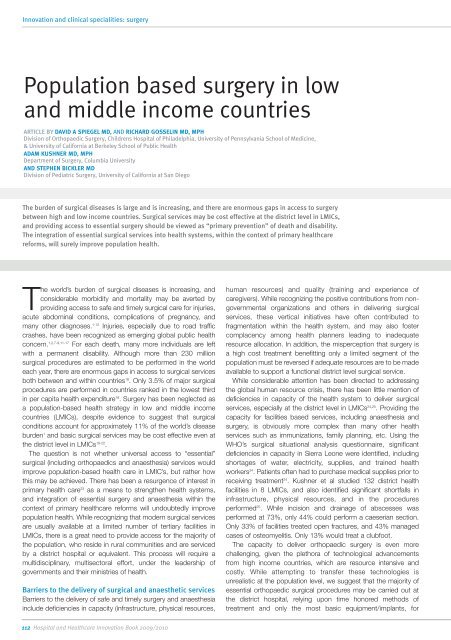Full document - International Hospital Federation
Full document - International Hospital Federation
Full document - International Hospital Federation
Create successful ePaper yourself
Turn your PDF publications into a flip-book with our unique Google optimized e-Paper software.
Innovation and clinical specialities: surgery<br />
Population based surgery in low<br />
and middle income countries<br />
ARTICLE BY DAVID A SPIEGEL MD, AND RICHARD GOSSELIN MD, MPH<br />
Division of Orthopaedic Surgery, Childrens <strong>Hospital</strong> of Philadelphia, University of Pennsylvania School of Medicine,<br />
& University of California at Berkeley School of Public Health<br />
ADAM KUSHNER MD, MPH<br />
Department of Surgery, Columbia University<br />
AND STEPHEN BICKLER MD<br />
Division of Pediatric Surgery, University of California at San Diego<br />
The burden of surgical diseases is large and is increasing, and there are enormous gaps in access to surgery<br />
between high and low income countries. Surgical services may be cost effective at the district level in LMICs,<br />
and providing access to essential surgery should be viewed as “primary prevention” of death and disability.<br />
The integration of essential surgical services into health systems, within the context of primary healthcare<br />
reforms, will surely improve population health.<br />
The world’s burden of surgical diseases is increasing, and<br />
considerable morbidity and mortality may be averted by<br />
providing access to safe and timely surgical care for injuries,<br />
acute abdominal conditions, complications of pregnancy, and<br />
many other diagnoses. 1-12 Injuries, especially due to road traffic<br />
crashes, have been recognized as emerging global public health<br />
concern. 1,2,7-9,11-17 For each death, many more individuals are left<br />
with a permanent disability. Although more than 230 million<br />
surgical procedures are estimated to be performed in the world<br />
each year, there are enormous gaps in access to surgical services<br />
both between and within countries 18 . Only 3.5% of major surgical<br />
procedures are performed in countries ranked in the lowest third<br />
in per capita health expenditure 18 . Surgery has been neglected as<br />
a population-based health strategy in low and middle income<br />
countries (LMICs), despite evidence to suggest that surgical<br />
conditions account for approximately 11% of the world’s disease<br />
burden 1 and basic surgical services may be cost effective even at<br />
the district level in LMICs 19-22 .<br />
The question is not whether universal access to “essential”<br />
surgical (including orthopaedics and anaesthesia) services would<br />
improve population-based health care in LMIC’s, but rather how<br />
this may be achieved. There has been a resurgence of interest in<br />
primary health care 23 as a means to strengthen health systems,<br />
and integration of essential surgery and anaesthesia within the<br />
context of primary healthcare reforms will undoubtedly improve<br />
population health. While recognizing that modern surgical services<br />
are usually available at a limited number of tertiary facilities in<br />
LMICs, there is a great need to provide access for the majority of<br />
the population, who reside in rural communities and are serviced<br />
by a district hospital or equivalent. This process will require a<br />
multidisciplinary, multisectoral effort, under the leadership of<br />
governments and their ministries of health.<br />
Barriers to the delivery of surgical and anaesthetic services<br />
Barriers to the delivery of safe and timely surgery and anaesthesia<br />
include deficiencies in capacity (infrastructure, physical resources,<br />
human resources) and quality (training and experience of<br />
caregivers). While recognizing the positive contributions from nongovernmental<br />
organizations and others in delivering surgical<br />
services, these vertical initiatives have often contributed to<br />
fragmentation within the health system, and may also foster<br />
complacency among health planners leading to inadequate<br />
resource allocation. In addition, the misperception that surgery is<br />
a high cost treatment benefitting only a limited segment of the<br />
population must be reversed if adequate resources are to be made<br />
available to support a functional district level surgical service.<br />
While considerable attention has been directed to addressing<br />
the global human resource crisis, there has been little mention of<br />
deficiencies in capacity of the health system to deliver surgical<br />
services, especially at the district level in LMICs 24,25 . Providing the<br />
capacity for facilities based services, including anaesthesia and<br />
surgery, is obviously more complex than many other health<br />
services such as immunizations, family planning, etc. Using the<br />
WHO’s surgical situational analysis questionnaire, significant<br />
deficiencies in capacity in Sierra Leone were identified, including<br />
shortages of water, electricity, supplies, and trained health<br />
workers 24 . Patients often had to purchase medical supplies prior to<br />
receiving treatment 24 . Kushner et al studied 132 district health<br />
facilities in 8 LMICs, and also identified significant shortfalls in<br />
infrastructure, physical resources, and in the procedures<br />
performed 25 . While incision and drainage of abscesses was<br />
performed at 73%, only 44% could perform a caeserian section.<br />
Only 33% of facilities treated open fractures, and 43% managed<br />
cases of osteomyelitis. Only 13% would treat a clubfoot.<br />
The capacity to deliver orthopaedic surgery is even more<br />
challenging, given the plethora of technological advancements<br />
from high income countries, which are resource intensive and<br />
costly. While attempting to transfer these technologies is<br />
unrealistic at the population level, we suggest that the majority of<br />
essential orthopaedic surgical procedures may be carried out at<br />
the district hospital, relying upon time honored methods of<br />
treatment and only the most basic equipment/implants, for<br />
112 <strong>Hospital</strong> and Healthcare Innovation Book 2009/2010

















